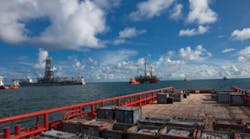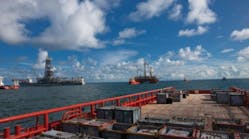BP PLC flushed hydrates from inside Transocean Ltd.'s Deepwater Horizon semisubmersible blowout preventer and a capping stack on the blown-out Macondo well in the Gulf of Mexico.
BP hoped to replace the Deepwater Horizon BOP on Aug. 26, but that timetable was pushed back by at least 24-36 hr.
National Incident Commander and retired US Coast Guard Adm. Thad Allen said hydrates prevented BP from opening a set of rams that it closed for pressure tests in the lower marine riser package. A 48-hr ambient pressure test concluded on Aug. 21, assuring officials the well remains shut in.
An Apr. 20 blowout of the Macondo well on Mississippi Canyon Block 252 caused an explosion and fire on the Deepwater Horizon, killing 11 people. The semi sank on Apr. 22.
During a "static kill" procedure, BP pumped heavy drilling mud and then cement into the casing from the top of the well following the July 15 installation of a capping stack (OGJ, Aug. 9, 2010, p. 27).
BP worked Aug. 25 to remove two pieces of drill pipe using a fishing operation and to evaluate the condition of a third drill pipe. Allen said an 18-in. long pipe is crosswise in the BOP. A second pipe, which is about 13 ft long, is standing parallel to a longer third pipe.
The third pipe, held suspended from the BOP, has been estimated at up to 3,500 ft long.
Allen said the long pipe might have been cut by a ram in which case BP expected to be able to remove that pipe by itself and then replace the Deepwater Horizon BOP before completing a relief well.
Another potential scenario is that the pipe was not cut and extends well below the BOP. This could mean that BP has to remove the pipe while it's still attached to the BOP, Allen said, adding that BP is formulating plans to do that if necessary.
There also was a chance that the pipe might be in contact with cement pumped into the well during the static kill.
"We're not ruling out the possibility that some cement could have adhered to it," Allen said. Consequently, BP engineers and federal scientists are studying "how much pull should we put on the blowout preventer."
The Deepwater Horizon BOP will be replaced with a BOP from Transocean's Development Driller II, which started a second relief well as a backup to the first relief well being drilled by Transocean's Development Driller III.
Allen said a stronger BOP needs to be put on Macondo before the first relief well can be completed to assure that the well has been killed from the bottom.
The USCG Marine Board of Investigation has issued a subpoena for the failed Deepwater Horizon BOP.
Planned sequence
Allen estimates the Development Driller III relief well could intercept the Macondo well the week after the Sept. 6 Labor Day holiday in the US, assuming a planned sequence of events goes smoothly without weather delays.
Kent Wells, BP's senior vice-president of exploration and production, said Transocean's Discoverer Enterprise drillship was positioned above Macondo on Mississippi Canyon Block 252.
Once ready to remove the BOP, crews planned to use the Enterprise to remove the capping stack. Crews would use the Helix Q4000 multiservice vessel to remove the BOP and bring it to the surface.
Wells said the DDII BOP then would be put on the Macondo wellhead and the bottom kill would be completed using the relief well drilled by the DDIII. Following the bottom kill, BP will plug and abandon the Macondo well.
"Our industry has some very clearly defined regulations and procedures on how we abandon the well," Wells said during an Aug. 19 technical briefing.
"We will go in and set a number of mechanical isolation devices…we'll put cement on top of them, and keep doing that up the hole…. Those will be sort of the final steps we'll take, and that will be very much routine, like we do with any well when we plug and abandon it."
Eventually, there will be no need for a BOP or a wellhead, he said. "It will be completely taken care of subsea, below the sea floor."
BP monitors water
On Aug. 25, BP planned to deploy two satellite-controlled, unmanned vehicles in the gulf as part of its long-term monitoring and research program.
The vehicles, known as Wave Gliders and developed by Liquid Robotics in Silicon Valley, Calif., receive propulsion power from wave action and use solar power for their electronics.
"These vehicles will provide us a steady stream of data about water quality and should significantly increase the available data for ongoing research activity," said Mike Utsler, chief operating office of BP's Gulf Coast restoration organization. "We will initially deploy the Wave Gliders between the Macondo well and the shoreline."
Sensors will monitor water for any emulsified, dissolved, and dispersed oil as well as monitoring for phytoplankton (chlorophyll) and colored, dissolved oxygen matter (CDOM).
Roger Hine, Liquid Robotics president and chief executive officer, said nine optical sensors will be calibrated to monitor water quality, including trace amounts of dispersed oil. The sensors later are expected to be calibrated to include acoustic monitoring of marine mammal activity.
A second pair of Wave Glider vehicles was scheduled to be deployed in September. Data collected by the vehicles will be relayed via satellite and posted on a public web site, BP said.
More Oil & Gas Journal Current Issue Articles
More Oil & Gas Journal Archives Issue Articles
View Oil and Gas Articles on PennEnergy.com


